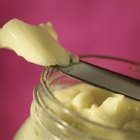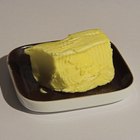
Simple American buttercream frosting is usually a safe bet, but when you venture into European territory, you're asking for trouble. Swiss, French and Italian buttercream frostings rely on an emulsion of eggs, butter and sugar, and any number of things can go wrong. If you're buttercream has turned to butter, the problem is usually the temperature of the ingredients. To fix it, warm the frosting up or cool it down, depending on its appearance.
The Problem
The most common reason buttercream turns to butter is simply because the butter is too soft or too hard. If the butter is too soft, you see pools of oil on top of the frosting and the frosting has a limp, soft texture like melted butter. If the butter is too hard, the frosting breaks down into grainy lumps that look like butter. The butter should be at room temperature -- neither cold nor warm.
Fixing Melted Buttercream
One of the simplest solutions for curing a melted batch of buttercream is to add a bit of cool -- not cold -- butter to the frosting. Allow 1/4 to 1/2 cup of butter to rest on the countertop for 30 to 60 minutes, or until it's just soft enough that your finger leaves a small indentation in it if you touch it. For a quicker fix, you can soften it in the microwave if you work carefully in 10- to 15-second intervals. Don't overdo it, though, or you'll soften it too much. Another simple fix is to add some shortening. Butter has a melting point between 88 and 98 degrees Fahrenheit, while shortening remains firm to 106 F. Adding shortening helps firm the softened butter and restore your frosting. Place the frosting in a stand mixer, or use a hand mixer, and beat it until it's light and fluffy.
Fixing Cold Buttercream
If the frosting has separated into grainy lumps, blow hot air from a hair dryer onto the bowl for a few seconds. The hot air melts the butter so that it can then be whipped into the frosting. Some stand mixers are powerful enough that you may be able to fix the frosting just by beating it longer. The frosting heats up slightly from the energy generated from the mixing blades.
An Ounce of Prevention
To prevent buttercream disasters, start with room-temperature ingredients. If you're making Swiss, Italian or French buttercream, use real eggs or egg whites, not meringue powder, and add a bit of cream of tartar to the eggs. Allow the meringue to cool to around 85 F, but no cooler, before adding the butter. Meringue that's either too hot or too cold can curdle the frosting. Sometimes the only thing you need is a bit more patience. When you first start adding butter to a cooked buttercream frosting, it may appear broken initially. Keep mixing and adding butter, and it will probably turn into light, fluffy frosting without any extra help.
Related Articles

How to Fix Lumpy Buttercream Frosting

Can You Use Melted Butter for Frosting ...

How to Quickly Thaw Butter

How to Keep Your Buttercream Icing With ...

How to Fix Grainy Whipped Ganache

How to Get Hot Pink Colored Frosting

How to Make Icing With Very Few ...

How to Fix Curdled Whipped Cream

How to Troubleshoot Seven Minute ...

The Cream for My Tiramisu Is Too Watery

How Can I Soften Frozen Butter for ...

Softened vs. Melted Butter When Baking

How to Fix Mayo With Broken Emulsion

How to Make Drizzle Icing From Frosting ...
How to Soften Crystalized Molasses
Best Homemade Cream Cheese Frosting

How to Melt Hershey's Chocolate
How to Make Bakery-Style Whipped Icing
How to Make White Drizzle Frosting

How to Store Ghee
References
Writer Bio
Julie Christensen is a food writer, caterer, and mom-chef. She's the creator of MarmaladeMom.org, dedicated to family fun and delicious food, and released a book titled "More Than Pot Roast: Fast, Fresh Slow Cooker Recipes."
Photo Credits
Digital Vision./Photodisc/Getty Images